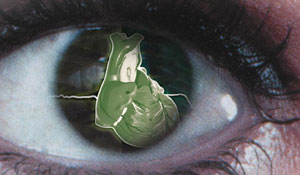|
by Tien Yin WONG

 eart disease, hypertension, stroke, and diabetes constitute the most common disease-related causes of death, disability, and morbidity in Singapore and the world. The scale, impact, and cost of these diseases make treatment a healthcare priority. eart disease, hypertension, stroke, and diabetes constitute the most common disease-related causes of death, disability, and morbidity in Singapore and the world. The scale, impact, and cost of these diseases make treatment a healthcare priority.
Identification of people at high risk traditionally uses such standard diagnostic tools as blood pressure readings and blood cholesterol measurement. However, these diagnostic tests have limits, and current diagnostic screenings alone fail to capture about 50% of these affected. Concurrently, the pharmaceutical industry has developed a plethora of new therapeutics; the need exists to address questions related to targeted treatment approaches, such as who is at risk, who requires treatment, when should treatment occur, and how should treatment be dispensed.
Retinal Blood Vessel Changes
A group of researchers from the Department of Ophthalmology and the School of Computing at the National University of Singapore (NUS), along with international colleagues in the US and Australia, has discovered a way to predict heart disease by looking into the windows of the soul — the eyes.
The retina provides a clue to human circulation. Changes in retinal blood vessels reflect similar damage elsewhere in the body. Retinal microvascular changes, such as retinal vessel narrowing, (in comparison with a normal retina), result from long-term damage due to ageing, elevated blood pressure, diabetes, and other conditions. New computer-based imaging technologies, such as systems currently being developed in NUS, allow precise quantification of these retinal changes. These computer programmes analyse digital retinal photographic images and identify subtle changes in retinal vessel caliber and other abnormalities. A fully automated web-based system is being designed.
The members of our research team have found that changes in the retinal microvascular system may predict stroke, heart disease, diabetes, hypertension, and dementia and even pinpoint mortality. Major journals such as Lancet and Journal of the American Medical Association have published these results. We have found that the prediction accuracy is strong, independent of current diagnostic methods, and applicable even to populations considered traditionally at low risk of vascular disease (for example, healthy, non-smoking, middle-aged men as well as women without family histories of vascular disease).
Ten-Year Prediction
Because retinal microvascular changes can in fact predict the development of vascular disease up to ten years before it might otherwise be diagnosed, as shown by a previous study by the team, the potential for screening and targeted treatment strategies is substantial.
We are expanding this research by building a Retinal Vascular Imaging Centre (RetVIC) that will put this knowledge to potential commercial and clinical use within the next five years. The new technology, which has potential application in telemedicine via Internet image acquisition and delivery from remote areas, is part of the NUS Singapore Epidemiology of Eye Disease (SEED) Programme, its local associates, and international affiliates.
Areas of Collaboration
The NUS team is working with a number of overseas collaborators in furthering the research and bringing it to a clinical environment. Plans include development of RetVIC at the Centre for Eye Research Australia at the University of Melbourne, as a separate site. It will coordinate Australian collaborators with several multicentral projects, including studies exploring other aspects of retinal vessel change in coronary/vascular disease and diabetes. The University of Sydney will collaborate by providing retinal images taken from the Blue Mountains Eye Study. The University of Wisconsin in the US will provide expert collaborative advice in retinal vessel imaging.
Locally, the Singapore General Hospital Stroke Unit will initiate a new clinical study to determine the relationship between retinal vascular change and prediction of acute stroke. The NUS School of Computing Basic will serve as a base for the computer imaging.
RetVIC will perform as a novel diagnostic testing centre. The tangible benefits include earlier identification of disease, leading to targeted and more effective intervention, which will ultimately translate into a reduction in the number of cases and substantial public healthcare savings. The concept of RetVIC has been shared with relevant medical and professional bodies, including leading cardiologists, neurologists, diabetologists, and ophthalmologists.
Improved prevention of heart attack, stroke, diabetes and other vascular diseases requires determination of new risk factors and developing innovative approaches to identification of high-risk persons. Retinal vascular imaging may provide a unique method for predicting people at risk of developing important cardiovascular disorders.
For more information contact Tien Ying Wong at ophwty@nus.edu.sg
 Click here to download the full issue for USD 6.50 Click here to download the full issue for USD 6.50
|



 eart disease, hypertension, stroke, and diabetes constitute the most common disease-related causes of death, disability, and morbidity in Singapore and the world. The scale, impact, and cost of these diseases make treatment a healthcare priority.
eart disease, hypertension, stroke, and diabetes constitute the most common disease-related causes of death, disability, and morbidity in Singapore and the world. The scale, impact, and cost of these diseases make treatment a healthcare priority.
 Click here to download the full issue for USD 6.50
Click here to download the full issue for USD 6.50